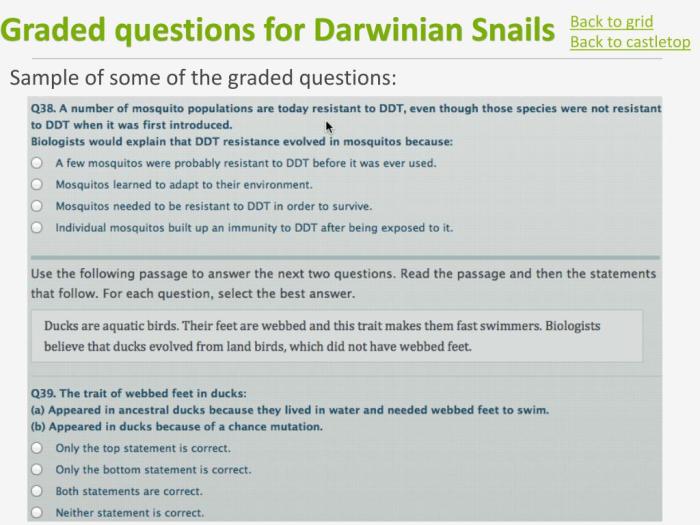Darwinian snails graded questions answers present an intriguing approach to understanding evolutionary processes and their educational value. By exploring the concept of graded questions answers, we uncover the significance of Darwinian snails in scientific research and their applications in teaching about evolution.
The concept of Darwinian snails and graded questions answers offers a unique perspective on evolutionary patterns and their implications for scientific research and education.
1. Introduction

Darwinian snails are a unique group of land snails that exhibit remarkable variation in shell morphology, providing a natural laboratory for studying evolutionary processes. Graded questions answers, a technique involving the presentation of a series of questions with increasing difficulty, have proven valuable in investigating the evolution of Darwinian snails.
Graded questions answers allow researchers to assess the relative difficulty of different traits, which can provide insights into the selective pressures that have shaped the evolution of these snails. By analyzing the patterns of trait difficulty, scientists can gain a better understanding of the mechanisms underlying evolutionary change.
2. Evolutionary Significance
Darwinian snails have played a significant role in our understanding of evolution. Their diverse shell morphologies have provided a rich source of data for studying the processes of natural selection, genetic variation, and adaptation.
Graded questions answers have contributed to our knowledge of evolution by allowing researchers to quantify the difficulty of different shell traits. This information has helped identify the selective pressures that have driven the evolution of these snails. For example, studies have shown that shells with more complex shapes are more difficult to produce, suggesting that natural selection has favored simpler shell morphologies in certain environments.
3. Applications in Research

Darwinian snails are used in various scientific research applications. They serve as a model system for studying evolutionary processes due to their rapid generation times, high fecundity, and well-defined shell morphologies.
Graded questions answers have been employed in numerous studies to investigate evolutionary patterns in Darwinian snails. Researchers have used this technique to examine the effects of environmental factors, such as predation and resource availability, on shell morphology. Additionally, graded questions answers have been used to study the genetic basis of shell variation and the evolution of developmental pathways.
4. Educational Value: Darwinian Snails Graded Questions Answers

Darwinian snails and graded questions answers offer a valuable educational tool for teaching about evolution. The diversity of shell morphologies and the ability to quantify trait difficulty make these snails an engaging and accessible subject for students.
Incorporating Darwinian snails and graded questions answers into lesson plans can help students understand the principles of natural selection, genetic variation, and adaptation. By analyzing the patterns of trait difficulty, students can gain insights into the selective pressures that have shaped the evolution of these snails and apply these concepts to other evolutionary systems.
5. Limitations and Challenges
While Darwinian snails and graded questions answers provide valuable insights into evolutionary processes, there are certain limitations and challenges associated with their use.
One limitation is the potential for environmental factors to influence the difficulty of shell traits. Environmental conditions, such as temperature and humidity, can affect the production and maintenance of shell morphology, which could confound the results of graded questions answers.
Additionally, the accuracy of graded questions answers relies on the expertise of the researchers conducting the study, as the difficulty of traits is subjective and can vary among different observers.
6. Future Directions

Research on Darwinian snails and graded questions answers continues to expand our understanding of evolutionary processes. Future directions include:
- Using graded questions answers to investigate the evolution of complex traits, such as those involved in reproductive behavior and communication.
- Combining graded questions answers with other techniques, such as genetic analysis and ecological modeling, to gain a more comprehensive understanding of evolutionary patterns.
- Applying graded questions answers to other model systems to test the generality of the findings from Darwinian snails.
FAQ Resource
What are Darwinian snails?
Darwinian snails are a group of land snails that exhibit a range of shell morphologies, providing a natural laboratory for studying evolutionary processes.
How do graded questions answers contribute to our understanding of evolution?
Graded questions answers allow researchers to quantify and compare the fitness of different shell morphologies, providing insights into the selective pressures that drive evolutionary change.
What are some applications of Darwinian snails in scientific research?
Darwinian snails have been used to study topics such as the evolution of phenotypic plasticity, the role of natural selection in shaping morphological diversity, and the genetic basis of adaptive traits.
How can Darwinian snails be used in teaching about evolution?
Darwinian snails provide a tangible and engaging way to teach students about evolutionary concepts such as natural selection, adaptation, and genetic variation.
What are some limitations or challenges associated with using Darwinian snails and graded questions answers?
Limitations include the potential for environmental factors to influence shell morphology, the difficulty in controlling for genetic variation, and the time-consuming nature of collecting and analyzing data.